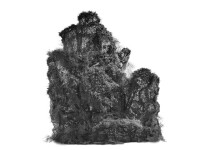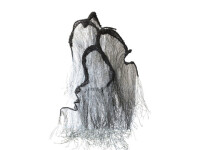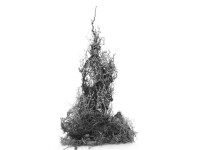共找到13條詞條名為黃鎮的結果 展開
黃鎮
中國雕塑家
黃鎮,1979年出生於福建莆田,畢業於中央美術學院雕塑系。
黃鎮,1979年出生於福建 莆田
2010年畢業於中央美術學院雕塑系 本科
2016年畢業於中央美術學院雕塑系 藝術碩士
2012年就職於中央美術學院雕塑系
現工作生活於北京
藝評網合作藝術家

山水2011
《時尚芭莎》 中國 2010年
《藝樹》 中國 2012年
《流動藝術2012》中國 2013年
《藝財-發現》黃鎮 中國 2014年
《sculpture》 美國 2015年4月

山水
《山 水》 H T 畫廊 北京
《兮》 者畫廊 北京

山水系列2013

水墨山水

水墨山水之一
2016年
呼吸-中國傳統文化的當代形塑 南京雕塑博物院 南京
新格調-承德當代雕塑邀請展 河北承德
國家藝術基金—繁星計劃 巡迴展 中國 日本 美國
2015年
十年有承 奧美零空間 北京
上海021博覽會 上海
中國風景《極》 龍藝榜美術館 北京
物性美學 萬荷美術館 北京
蕪湖雕塑大展 安徽
明天青年雕塑展 成都 藍頂美術館 四川
明天當代雕塑獎 四川美院 重慶
2014年
第十二屆全國美展雕塑展 山西太原市美術館 太原
《 靜悟》 今日美術館 北京
萬和春季藝術沙龍展-再造空間3+2 萬荷美術館 北京
ASIAN CONTEMPORARY ART PART ‖ 美國 邁阿密
2013年
從卡塞爾走來 中國 漳州
大同國際雕塑雙年展 大同雕塑博物館 大同
流動藝術2013聯展 中華世紀壇 北京
築夢時間——東湖2013全國青年雕塑家邀請賽暨優秀作品展 武漢
新風景2 季節畫廊 北京
2012年
雕塑中國 中央美術學院 北京
2010年
千里之行 中央美術學院 北京
白兔十年回顧展 澳大利亞 悉尼
2009年
宋庄藝術節——精神儀式 北京
Building the Image: The Sculpture of Huang Zhen
In recent travels to Beijing, I have looked for good young sculptors, but I have been mostly disappointed. A visit to the huge sculpture studio of the Central Academy of Fine Arts (CAFA), acknowledged the best art school in China, convinced me of the technical skill of the students, who were working on a copy of a public memorial in Tienanmen Square. But while gifted, the students were pouring their energy into a gigantic relief that, unfortunately, had little to offer beyond a certain expertise in figuration. In a small room off of the studio, there was also a show by half a dozen post-graduate students, whose representational work again demonstrated considerable finesse, but lacked conceptual force of any kind. Indeed, in absurd fashion, the viewer even found examples in the show of seemingly earnest chinoiserie—nude girls in art deco surroundings. Such pieces prove the technical efficacy of the conservative Chinese education system, which imitates the Western academic model, with its emphasis on figuration and close detail. But the work also made it clear that however advanced their skills may be, the students lack a clear idea of what to sculpt
Fortunately, this general perception of Chinese sculpture is only accurate to a point: the exception often proves the rule. In the case of the highly gifted sculptor Huang Zhen, himself trained at CAFA and now an instructor there, we can see how the application of academic principles is given new life and intensity. Interestingly, his three-dimensional work is inspired by a close reading of traditional Chinese painting. So it is not so much a melding of different cultures as it is a conscious return to the great legacy of Chinese ink works—in the form of a coiled steel (bent by Huang himself) mountain, tree, or rock. These works are semi-monumental in feeling—that is, large enough to impress and suggest the natural forms they are based on, but still keyed to the human body. They are also deliberately Chinese in influence. Chinese art in general seems to be moving a bit away from Western influence; for example, ink painting, considered nearly a folk art for some time, has been making a comeback. Consequently, Huang’s lyric mountain, semitransparent yet marvelously substantial as an object, may be seen as a translation from one medium to another. The transitioning of one media category into the next—that is, from painting into sculpture—gives Huang’s art contemporaneity without sacrificing a connection to traditional arts.
The metal wire, wound by hand, offers weight and transparency at the same time. Huang’s marvelously realized mountain shows us how a painted composition might take place as a three-dimensional piece; rising some five to six feet into the air, the work possesses the gravity of a massive form—while maintaining dimensions that relate to the human body. Interestingly, Huang’s photograph emphasizes the empty space between the coils of steel, making the sculpture impossibly airy even as its overall form connotes substantial materiality. The mountain is an elegiac work, joining Huang’s other recent efforts in an atmosphere of serious play, highlighted by the poetic attention both to detail and the work’s overall gestalt. The lyric aspect of ink painting is repeated in this sculpture and other works by Huang, who, as a relatively young man in his thirties, maintains a youthful outlook. Reconciling Chinese contemporary sculpture with the historical legacy of ink painting, Huang’s art bridges the gap between the past and the present. Of course, In contemporary Chinese sculpture there is more than one kind of style—we have only to think of the Gao Brothers, whose broad irony consists of female Maos with bulbous breasts. These works would not be possible without knowledge of Western sculptural practices.
Yet, interestingly, Huang does not turn toward irony. Instead, he makes use of his esthetic inheritance by connecting with the gracefulness of the art that preceded him. This does not mean, however, that he is only investigating the past. The sculpture contemporizes the classical Chinese painting tradition, which has been mostly moribund (with certain outstanding exceptions) during the last century. The willow tree created by Huang stands out as an example of gracefulness, adding to his poetic reading of the past. Figured to the size of the artist or viewer, this piece relates to studies by painters that would seem untranslatable from their initial medium. One also recognizes, on seeing the tree, that the attractiveness of Huang’s output stems from his willingness to build a beautiful image. This kind of work exists in strong contrast to the overly theoretical, deliberately alienating facture we often experience in Western sculpture. Somehow the inheritance of Chinese painting survives in Huang’s art, which forges a new path by remembering tradition. Such an orientation toward creativity contrasts strongly with Western notions that the work should be original, without precedent, and relentlessly new.
The final work discussed here is a large rock—not a scholar’s stone, but simply a rock. Its haphazard shape recalls in a superficial way the formless wire sculptures of Alan Saret, the New York-based artist. Yet the efforts of the two sculptors could not be more different—whereas Saret’s shapes defy close formal analysis, Huang’s efforts are more or less tied to the natural form that acts as a visual template for each sculpture. By neither slavishly copying his inspiration, nor succumbing to the excessive informality we often experience in art outside China, we find something of a middle ground in Huang’s work. The stone occupies its space with a weight and dignity that is unusual in contemporary art. Finally, the contrast between the coiled forms and the open spaces between them argue successfully for an essential tension, or alternatively a balance, in formal terms. Huang is a subtle and intelligent artist. He maintains classical strictures without appearing dogmatic, which by itself is an unusual achievement. One hopes his work will become better known in the West as time goes on.
Jonathan Goodman
